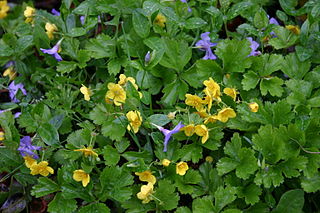
Waldsteinia fragarioides (syn. Dalibarda fragarioides Michx. and Geum fragarioides, also called Appalachian barren strawberry, or just barren strawberry, is a low, spreading plant with showy yellow flowers that appear in early spring. This plant is often used as an underplanting in perennial gardens.

Viola canadensis is a flowering plant in the Violaceae family. It is commonly known as Canadian white violet, Canada violet, tall white violet, or white violet. It is widespread across much of Canada and the United States, from Alaska to Newfoundland, south as far as Georgia and Arizona. It is a perennial herb and the Latin specific epithet canadensis means of Canada.

Antennaria howellii is a North American species in the genus Antennaria within the family Asteraceae. It is native to northern Alaska, much of Canada including the Arctic territories, and the northern United States as far south as northern California, Colorado and North Carolina.

Senna hebecarpa, with the common names American senna and wild senna, is a species of legume native to eastern North America.

Viola adunca is a species of violet known by the common names hookedspur violet, early blue violet, sand violet, and western dog violet. It is native to meadows and forests of western North America, Canada, and the northern contiguous United States.

Orthilia is a genus of flowering plants in the family Ericaceae. It has only one species, Orthilia secunda. Its common names are sidebells wintergreen, one-sided-wintergreen and serrated-wintergreen. It is also called one-sided pyrola, one-sided shinleaf, and one-sided wintergreen. It was previously part of genus Pyrola, the wintergreens.

Rosa nitida, also known as the shining rose due to its glossy leaves, is a perennial species in the plant genus Rosa in the plant family Rosaceae. It is native to northeastern North America, from Connecticut north to Newfoundland and Quebec. It forms a low, suckering, deciduous shrub, growing up to a metre in height, although often less. Its stems are thin and covered in fine bristles. Its pinnate leaves have 7 to 9 shining leaflets which turn bright red, yellow and purple in the fall. Its small pink flowers appear in summer and are subtly but sweetly scented, smelling like Convallaria ("Lily-of-the-Valley"). They are followed by small, round, red hips.
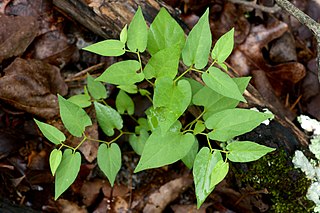
Aristolochia serpentaria is a species of perennial flowering plant in the Aristolochiaceae (birthwort) family. The species is commonly known as Virginia snakeroot and is native to eastern North America, from Connecticut to southern Michigan and south to Texas and Florida.
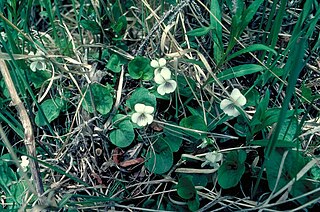
Viola renifolia is a species of violet known by the common names white violet and kidneyleaf violet. It is native to northern North America, where it has a widespread distribution across Canada and the northern United States as far south as Washington, Colorado, and New York.

Viola selkirkii is a species of violet known by the common names Selkirk's violet and great-spur violet. It is native throughout the Northern Hemisphere, its distribution circumboreal.

Sagittaria teres, the quill-leaved arrowhead or slender arrowhead, is an aquatic plant species of arrowhead native to the northeastern United States: Rhode Island, Massachusetts, New Hampshire, New York and New Jersey.

Solidago latissimifolia, common name Elliott's goldenrod, is North American species of flowering plants in the family Asteraceae. It is native to the Atlantic Coast of the United States and Canada, from Nova Scotia south to Alabama and Florida.
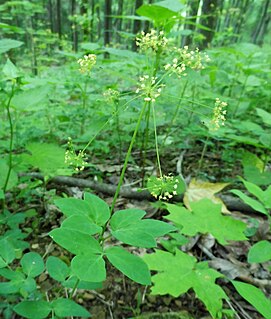
Taenidia integerrima, the yellow pimpernel, is an herbaceous plant in the parsley family. It is native to the eastern North America, where it is widespread. Its natural habitat is rocky prairies and woodlands, often over calcareous substrates. It is a perennial.
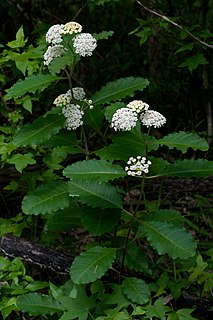
Asclepias variegata, commonly called the redring milkweed or white milkweed, is a plant in the family Apocynaceae. It is native to eastern North America, where it is found in Canada and the United States. It is most common in the Southeastern United States, and becomes rare in the northern edge of its range.

Viola brittoniana, known as coast violet, northern coastal violet and Britton's violet, is a rare, acaulescent blue-flowered violet that is endemic to the eastern United States. It has distinctive leaves with narrow lobes and deep sinuses. It is a perennial.
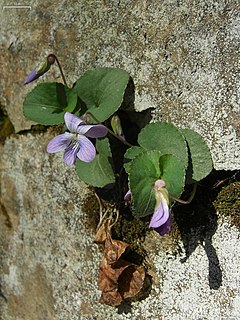
Viola hirsutula, common name southern woodland violet, is a perennial species of violet found in the eastern United States.

Atriplex glabriuscula, common names Scotland orache, smooth orache, Babington's orache or seaside orach is an Atriplex species native to North America and northern Europe. It is an annual.
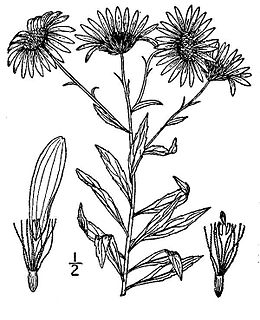
Oclemena nemoralis, common names bog aster or bog nodding aster, is a plant native to the northeastern United States. Its range extends into southeastern Canada.
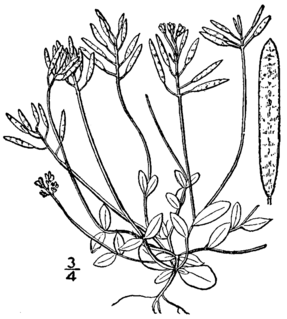
Draba reptans, common names Carolina draba, Carolina whitlow-grass, Creeping whitlow-grass, and Whitlow-grass, is an annual plant in the family Brassicaceae that is native to North America.




















